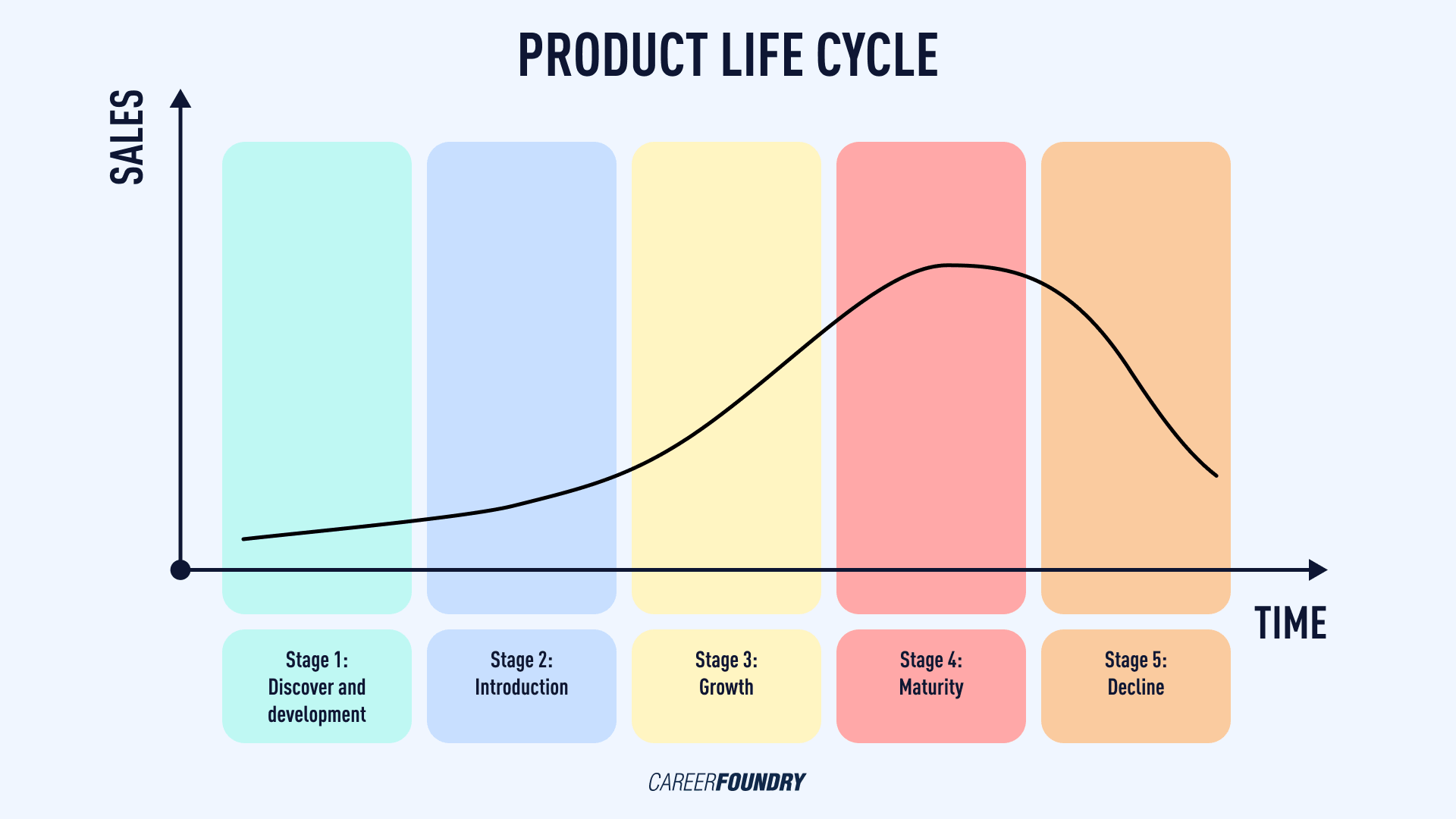The product development life cycle (PDLC) is an important concept to understand for anyone involved with product management. The term is closely related to the product life cycle (PDC) but has different implications for product strategy and development.
Grasping this difference is critical for product managers (PMs) who want to guide their products through the development process and ensure they have a foundation of successful strategies in place, from ideation to launch and beyond.
To help demystify this process, we’ll break down the product development life cycle into its main stages and explain how they work together to build a successful product development strategy.
If you’d like to skip ahead to a particular section, just use the clickable menu:
- What is the product development life cycle?
- What are the 7 stages of the product development life cycle?
- What is product development strategy?
- Final thoughts
1. What is the product development life cycle?
The PDLC is an iterative cycle of continuous improvement and optimization.
It’s the process of taking a product from an idea to its market release and beyond, involving many departments in the organization, such as research and development, marketing, design, and production.
The cycle is typically broken down into seven stages:
- ideation
- research
- validation
- development
- production
- launch
- post-launch
At each stage of the process, there are important decisions to be made that will affect the success of the product.
By understanding and following these steps in the product development cycle, organizations can create successful products that meet customer needs and stand out in the market.
Therefore, this continuous improvement framework is critical in gaining a competitive advantage and optimizing the product development process.
Product life cycle vs product development life cycle
Although PLC and PDLC are terms that may seem interchangeable, they’re actually quite different.
The product’s life cycle refers to the various stages a product goes through during its entire lifespan, from conception and development to launch and discontinuation. So, the focus here is on the product’s entire journey, from start to finish.

By comparison, the product development life cycle refers to the process of bringing a product from ideation to market launch. In other words, it’s the sequence of activities that takes a product from concept to completion.
Progressing through a product development life cycle is a highly interactive experience involving multiple teams, departments, and work processes.
So, while the PLC concentrates on the product’s status at different stages of its existence, the PDLC refers to the processes used to create and refine the product throughout its development.
Product development life cycle vs software development life cycle
Another important distinction is between PDLC and the software development life cycle (SDLC), although the difference is simpler this time.
The SDLC is a specific type of product development life cycle, focusing on the steps and processes used to create software applications. It typically consists of the following stages:
- requirements
- design
- implementation
- testing
- deployment
- maintenance
So, the main difference between the two development life cycles is simply their area of focus—PDLC encompasses a broader range of product types, whereas SDLC is specific to software products.
2. What are the 7 stages of the product development life cycle?
Having established what PDLC is and how it differs from other related terms, let’s now take a closer look at the seven product development life cycle stages.
1. Ideation
Idea generation is part of the conceptualization stage of product management.
It involves creating a list of potential product ideas based on customer needs, market research, or new technology trends. For example, a company could discover a gap in the market or spot an opportunity to improve on existing products.
Once the product development team has identified a promising product idea and assessed its potential, the product can progress to the next stage in the cycle.
2. Research
At this point in the planning phase, the team must conduct market research to understand their target audience, potential customers, and competitors in-depth. This market analysis helps guide product decisions and assess the viability of different features.
When building a software product, it’s also essential to determine the target platform and any necessary hardware requirements. That’s why the research phase often sets the foundation for the product’s technical roadmap, including the development platform, software tools, and design technologies.
This is also the time when product requirements documents (PRDs) are drafted to define product features and technical specifications.
3. Validation
The next stage in the product development life cycle is validation. Here, the product team sets out to verify its initial research findings by conducting user tests and surveys, interviews, and focus groups.
Apart from validating the product idea, the aim of the research carried out at this stage is to gather data that will inform product design decisions.
That data is also used to determine how much time and money needs to be invested in the product’s development.
4. Development
This leads us to the development stage of the product life cycle. In this phase, prototypes and alpha (testing) versions are created for user feedback and testing in real-world scenarios. Based on customer feedback and user tests, the development team can refine the product design and make any necessary changes.
Sometimes, the development team may also decide to build a minimum viable product (MVP) first—a minimum version of the product with just enough features to meet customer needs. This helps the team identify any issues before investing too much time and money into a product that may never see the light of day.
5. Production
When the product is ready for commercial use, it enters the production phase. This is when all of the necessary components are built and assembled before undergoing quality assurance (QA) tests.
Essentially, QA tests verify that the product works as expected and meets all technical specifications. This is done by running simulations and applying different types of testing, such as usability, performance, compatibility, or security testing.
Additionally, any changes made during production should be documented to keep track of modifications or improvements made along the way. Finally, the product is also prepared for packaging and distribution.
6. Launch and delivery
Once the product is ready for launch, marketing efforts are ramped up, and the product is released or made available to customers. This includes marketing campaigns, promotional activities, website updates, and any other marketing-related tasks.
During this growth stage, the marketing department works to create hype and build anticipation for the launch.
At the same time, the product development team is responsible for the actual delivery and deployment of the product. This could involve setting up customer accounts, creating a support system, or managing other development processes.
7. Post-launch evaluation
But the product development life cycle is only complete with post-launch evaluation. The aim of this maturity stage is to gather customer feedback, measure customer satisfaction, and analyze product quality and performance.
This is done by collecting product usage data and tracking product metrics, such as sales figures, user engagement rates, churn rates, and product feedback. This data is then used to inform product decisions, such as product feature improvement or product optimization initiatives.
So, there you go: the product development life cycle in a nutshell. But how does all this fit into product development strategy, more generally?

3. What is a product development strategy?
To put it simply, product development strategy is the process of setting business objectives and planning how to achieve them.
As a product manager, you need to understand customer needs, market trends, technical constraints, and the product development life cycle to craft a strategy that will ensure the success of your product.
The relationship between product development and product strategy is ultimately one of interdependence: the product strategy guides the development process, while the development process helps to shape and refine the overall product strategy.
This means that the two must be constantly examined, adjusted, and—if necessary—re-aligned to ensure they remain in sync.
4. Final thoughts
The product development life cycle is an essential part of product development. It outlines the key stages of the product development process, from idea conception to post-launch evaluation.
But the term PDLC shouldn’t be viewed in isolation, as it’s closely related to product life cycle (PLC) and software development life cycle (SDLC). By understanding slight nuances between these three terms and how they relate to product strategy in general, product managers can gain valuable insight into how to effectively manage their products, thereby optimizing the chances of success in the market.
Interested in learning more about the world of product development? Why not try out this free, 5-day introductory course to product management?
Enjoyed this article? Then we think you’ll like these, too:
